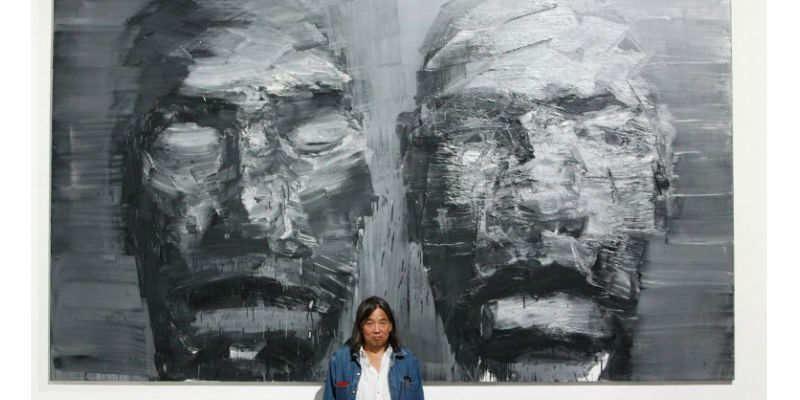
PARIS — The day after Moamer Kadhafi died, Chinese artist Yan Pei-Ming set to work painting a wall-sized oil of his corpse — the first in an unlikely trio of artworks inspired by the Libyan strongman’s grisly demise.
“He died such a dramatic, cruel death,” the artist, who lives and works in France, told Agence France-Presse. “He became a victim of his own victims”.
“The day after he died, I started work on the subject based on the images that were available to me.”
Entitled simply “Kadhafi’s corpse, October 21, 2011”, the resulting artwork went on display at the David Zwirner gallery in New York last spring — although it has yet to find a buyer.
Measuring 4.0 meters by 2.8 (13 feet by 9), the oil in shades of grey depicts the dictator’s body lying on the ground, in a mortuary chamber in the Libyan city of Misrata.
“All revolutions end in blood. It’s an eye for an eye, a tooth for a tooth,” added Yan, who was born in 1960 and lived through China’s cultural revolution before arriving in France in 1980.
The artist, who made a name for large monochrome paintings of historic figures, had previously depicted Mao Zedong on his death bed.
His Kadhafi work was shown as part of a series entitled “Black Paintings”, a reference to the dark works produced by the Spanish master Francisco Goya at the end of his life.
While Arab artists so far seem to have shied away from Kadhafi’s death as subject matter, according to the Arab World Institute in Paris, at least two European artists have also tackled it.
Britain’s Jenny Saville, 42, is working on a giant painting of Kadhafi’s corpse, his face spotted with blood amid a whirlwind of grey and black hues, surrounded by mobile phones.
“What I found most disturbing about the (press) images was not Kadhafi’s body, or the light, but the telephones,” Saville said this year in a forum at Modern Art Oxford, a British gallery where she held her first solo exhibition.
“(There was) this incredible body lying out in this cold storage unit with hundreds of hands holding telephones,” said Saville, whose work has often focused on the body and its deformities.
Saville, who was born in Cambridge and works out of a studio in Oxford, has been one of the most expensive artists in the world over the last 15 years.
The lesser-known Italian artist Luca del Baldo is also to showcase a series of works built around the death of Libya’s iron-fisted ruler, as part of an exhibition opening in mid-December near Como in northern Italy.
One of them, entitled “Ubu King, Kadhafi’s head”, shows the dictator’s mutilated face in shades of blue and red.
“I am not trying to cause a scandal, or to shock people,” explained the artist, who says he received anonymous emails ordering him to take all Kadhafi-related work off his website.
“An artist cannot only produce work to decorate museum or apartment walls,” he told AFP. “Goya, too, used to depict violence and death.”
Fascinated like Saville by the human body — and by corpses — del Baldo said his idea “was not to show Kadhafi as a figure to be idolized.”
“For me, he’s a kind of mafia boss, with an actor’s side to him. He’s a bit like a character out of an operetta — at the same time as being a dictator.”
While the three works on Kadhafi were enough to justify a focus article in a specialist review, The Art Newspaper, earlier this month, experts say they remain an isolated phenomenon.
The monitoring firm Artprice found next to nothing when searching for “Kadhafi” in its image database.
And the Arab World Institute, which closely follows the contemporary Arab art scene, told AFP it has spotted nothing on the subject.